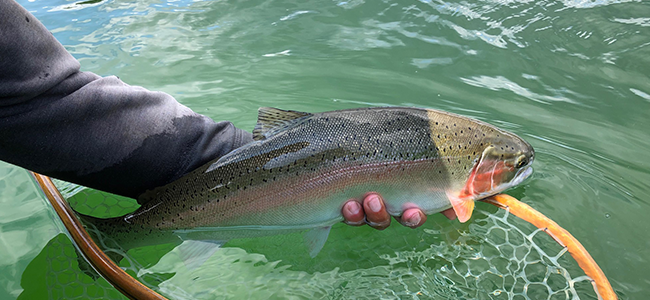Anglers looking forward to their first camping trip to the Interior of B.C. are in for a treat – multiple aquatic insect hatches will greet them on arrival. Water temperatures during the month of June are ideal for chironomid, mayfly, damselfly, and caddisfly emergences. In fact, it is not uncommon to experience several of these emergences at the same time on the same day. The availability of this smorgasbord of trout food means that, prior to your trip, you need to do some planning on equipment and fly-pattern selection.
Chironomid Hatches
Looking at hatch charts for our Interior trout lakes, you will quickly note that chironomid emergences are still prominent throughout June. Make sure you have some standard go-to colours and sizes of chironomid pupae; they will get used, and catch fish. Black bodies with red ribs, chromies with black or red rib, anti-static bag pupae with brown wire rib, and bright-green with gold or silver ribs are all good colour combinations. Have these patterns tied up on scud hooks in sizes #10 to #14, and also on long-shanked nymph hooks in sizes #12 and #14.
Mayflies
Callibaetis mayflies start emerging from lower-elevation Interior lakes by about the third week of May, but their most intense hatches often occur during June. Mayfly emergences are much shorter in duration and intensity than chironomids, but rainbow and brook trout know when they are hatching. Trout will feed extensively on migrating nymphs, as well as newly emerged adults while they sit on the water. Make sure you have some Pheasant Tail and Hare’s Ear nymphs (with and without gold bead heads), along with some Parachute Adams adult patterns in your fly box. Have the nymphs tied on #14 and #16 long-shanked nymph hooks, and the adult imitations on #12 and #14 dry-fly hooks.
Damselflies
Mid-June is prime time to see damselfly emergences. Mature nymphs migrate to stands of long-stem bulrushes or cattails, and then crawl up the stems and out of the water to complete their transition to the adult phase. Looking over the side of your boat and seeing damselfly nymphs swimming by is a sure sign that a hatch is occurring. These swimming nymphs make easy meals for trout cruising the shallower water found over shoal areas of a lake. Light- to dark-olive damsel nymph patterns tied on #12 and #10 long-shank nymph hooks are perfect for imitating these mature nymphs.
Caddisflies
By the third week of June, and extending well into July, we see emergences of caddisflies on many of the most productive or nutrient-rich Interior trout lakes. The most obvious indication of a caddis hatch is spotting adults scurrying across the surface film, then suddenly disappearing in large, swirling riseforms. Trout and char will feed on mature pupae swimming quickly to the surface to emerge into the adult stage. They will also chase down scampering adult caddisflies attempting to get airborne. Since there are small- and large-sized caddis species found in our Interior lakes, have a variety of pupal patterns tied on #12, #10, and #8 long-shanked nymph hooks to cover whichever may be emerging. Most of the larger caddis pupae have medium- to dark-green bodies with prominent, bright chartreuse-green ribs. Smaller species tend to have dark-olive to dark-brown bodies. Make sure you have some adult caddis imitations like Tom Thumbs, Mikaluk Sedges, or Goddard Caddis in sizes similar to the pupal stage.
Fly Line Selection
Essential fly lines to have for all of these hatches include floating, intermediate sinking, and type 3 full sinking lines. Since the larval and nymphal stages of all these insects reside in water less than six metres (20 feet) deep, that is where the majority of emergences will happen. Keeping a watchful eye on and into the water, and looking for signs of birds feeding over the water will provide important clues as to what insect is hatching.
Local fly and tackle shops are a valuable resource to help you prepare for any upcoming fishing trip to our Interior. They can supply the right fly patterns or provide the materials to tie them, as well as offer sound advice on how to fish them.
June is one of the best months to be on our trout lakes; it’s time to enjoy some great fishing throughout B.C.’s Interior.
Author: Brian Chan
Images: Brian Chan
